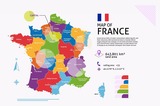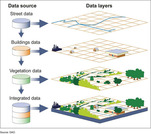
Students will practice looking at different parts of Paris on a map and practice describing their family members.
- Subject:
- Languages
- Material Type:
- Activity/Lab
- Author:
- Mimi Fahnstrom
- Camille Daw
- Amber Hoye
- Brenna McNeil
- Date Added:
- 12/03/2020

Students will practice looking at different parts of Paris on a map and practice describing their family members.

From the earliest days of settlement and migration, the people of North America have relied on maps and mapping to understand their environment and place within it. Maps have helped Americans prospect investments, comprehend war, and plan leisure in places unknown. As Americans have used maps to explore the U.S., capitalize on its resources, and displace its Native peoples, maps have shaped American cultural ideas about travel, place, and ownership. This exhibit explores the cultural and historic impact of mapping through four specific moments in American history: migration along the Oregon Trail, the rise of the lumber industry, the Civil War, and the popularization of the automobile and individual tourism. It concludes with a look at maps in the age of computers, the Internet, and beyond. These moments demonstrate the influence maps have had over how Americans imagine, exploit, and interact with national geographies and local places. This exhibition was created as part of the DPLAs Digital Curation Program by the following students in Professor Helene Williams's capstone course at the Information School at the University of Washington: Greg Bem, Kili Bergau, Emily Felt, and Jessica Blanchard. Additional revisions and selections made by Greg Bem.

In GEOG 489, you will learn advanced applications of Python for developing and customizing GIS software, designing user interfaces, solving complex geoprocessing tasks, and leveraging open source. The course consists of readings, walkthroughs, projects, quizzes, and discussions about advanced GIS programming concepts and techniques, and a final term project. It complements the material covered in GEOG 485: GIS Programming and Customization. Software covered in the course includes: Esri ArcGIS Pro/arcpy, Jupyter Notebook, Esri ArcGIS API for Python, QGIS, GDAL/OGR. Students will also use of the Git version control software for code management, and learn techniques for distributing Python applications to end users.

A geographic information system (GIS) is a computer system for capturing, storing, checking, and displaying data related to positions on Earth’s surface.

The Geographic Alliance of Iowa (GAI) was established in 1991 with the support of the National Geographic Society (NGS). GAI is composed of K-12 teachers, college and university professors, personnel from a variety of other educational endeavors, and citizens, all of who are concerned with improving geographic instruction in Iowa. As the only entity in Iowa specifically devoted to geography education, the mission of the Geographic Alliance of Iowa (GAI) is to help ensure K-12 graduates are geographically literate citizens. To achieve this mission, the GAI provides resources and expertise to improve the geographic literacy of Iowa students. With a particular focus on K-12 education, including pre-service teachers, the GAI provides exemplary professional development opportunities that follow accepted best practices and offers a clearinghouse of accessible, high quality, standards-based curricular materials.

After second grade students learn about Earth's systems and maps, students are challenged with designing a relief map of a community park.

In this activity, students create and interpret a water table contour map. Students utilize groundwater well elevations and the depth to the water table at each well to determine the water table elevation at each well location. Then they utilize that information to create a contour map of the water table and determine the direction of groundwater flow.

The Hotchkiss Map Collection contains cartographic items made by Major Jedediah Hotchkiss (1828-1899), a topographic engineer in the Confederate Army. Hotchkiss made detailed battle maps primarily of the Shenandoah Valley, some of which were used by the Generals Robert E. Lee and Thomas J. "Stonewall" Jackson for their combat planning and strategy. Several of the maps have annotations of various military officers, demonstrating their importance in the military campaigns. The collection also includes maps made or used by Hotchkiss during his post-war years, including maps with information about railroads, minerals and mining, geology and history, most of which focus on Virginia and West Virginia, but also cover other states and even the world. The collection consists of 341 sketchbooks, manuscripts, and annotated printed maps, the originals of which reside in the Library of Congress' Geography and Map Division.

This activity introduces students to using Google Earth and adding layers to google earth, while re-enforcing plate tectonic concepts and evidence for plate tectonics.
Outcomes:
1. Download Google Earth onto computer
2. Turn on/off layers within Google Earth
3. Be able to change measurement and use ruler within Google Earth
4. Determine latitude and longitude of ocean basin features
5. Be able to search for locations within Google Earth
6. Learn to upload new layers into Google Earth from .kmz files
7. Describe different plate boundaries, their locations and boundary interactions
8. Explain evidence for Plate Tectonics

Here you can find nearly all of Iowa’s 99 counties atlases in digital collection. In addition, county atlases from the late 1800s and the early 1900s are being digitized.

Iowa Culture is a mobile app that is a fun and interactive way to discover arts, history and cultural destinations in Iowa. Explore places by category and location, browse featured tours and save favorites to create your own Iowa Culture adventure. The possibilities are endless with mapping tools to direct you to more than 3,500 sites across 99 counties covering 56,272 square miles. Iowa Culture is a project by the Iowa Department of Cultural Affairs. The department empowers Iowa to build and sustain culturally vibrant communities by connecting Iowans to the people, places and points of pride that define our state.

The Iowa Digital Library features more than a million digital objects created from the holdings of the University of Iowa Libraries and its campus partners. Included are illuminated manuscripts, historic maps, fine art, historic newspapers, scholarly works, and more. Digital collections are coordinated by the Digital Scholarship & Publishing Studio.

Poster showing an outline map of Ireland, with detail maps showing locations of noted battles. Title from item. Caption: The battles in which Irish regiments have received prominent notice are shewn above.

Poster showing a map of Great Britain, with districts of army regiments indicated. Title from item. Poster no. 126. WT 7897/559.

This article gives background information on the Iditarod race in Alaska and shows how the race can be used in Grades K-5 classrooms to incorporate science, geography and language arts. The author provides links to resources that involve reading expository tests and writing assignments as well as working with real-time data. The article appears in the free, online magazine Beyond Penguins and Polar Bears.

In this task students figure out how to draw the longest line on a map of the United States without hitting a border. They use color and line plots to keep track of their results.

The Louisiana Purchase is a landmark event in American history, one that had a lasting impact not only on the size of the United States, but also on its economic, cultural, and political makeup. This presentation focuses on the various documents - from maps to newspapers to cultural artifacts - that help to describe the region of North America that stretched from as far east as Alabama into what is now the state of Montana.

This site includes maps created back to the early 16th century, when exploration and new discoveries brought the need for improved information about the world. The maps, most of which are hand drawn, depict portions of five continents and were prepared by cartographers from Spain, Portugal, France, Great Britain, the Netherlands, Latin America countries, and the U.S., among others. The maps represent different national and political interests and perspectives, at various periods of time.

This collection of maps from MAPS ETC show demographic information for the United states ranging from 1700 to the early 20th century.

The following map analysis worksheet was designed and developed by the Education Staff of the National Archives and Records Administration. You may find this worksheet useful as you introduce students to maps as primary sources of historical, social and cultural information.